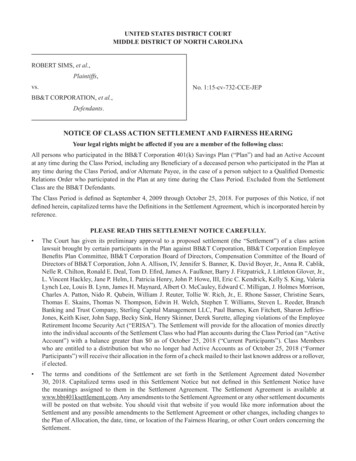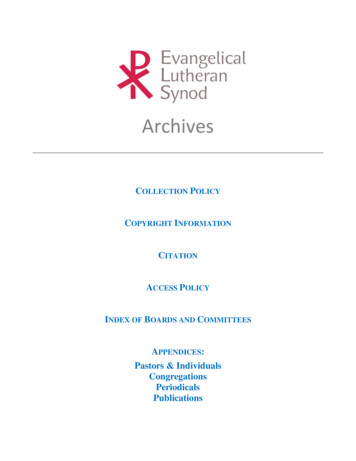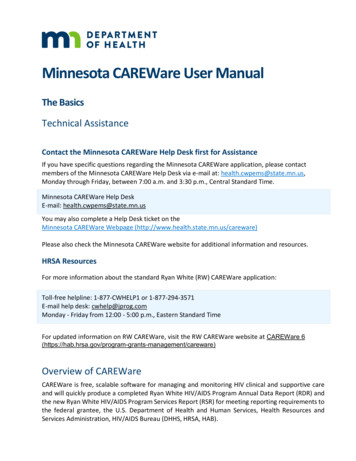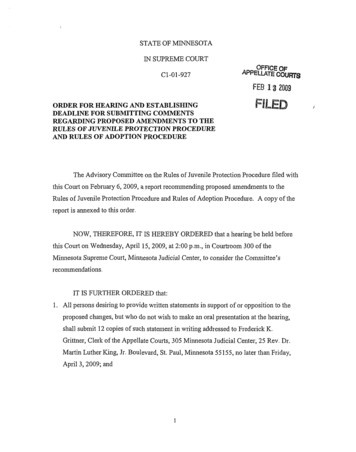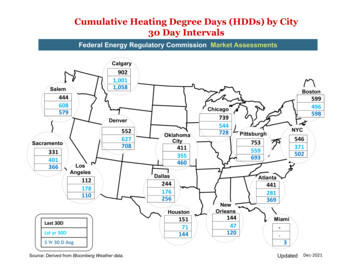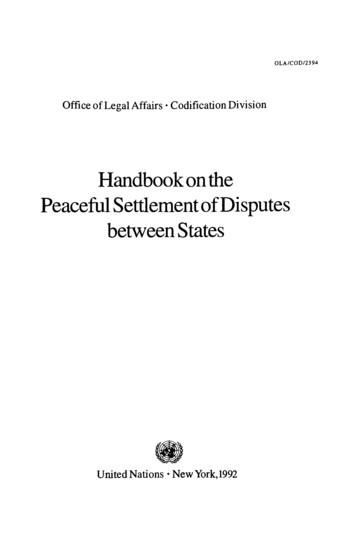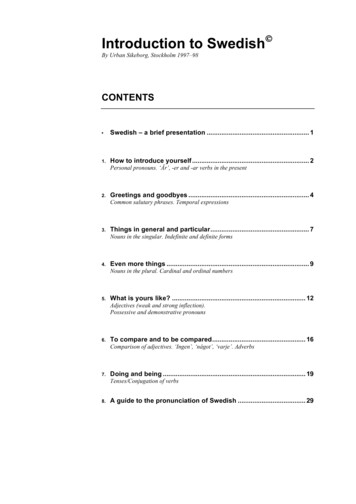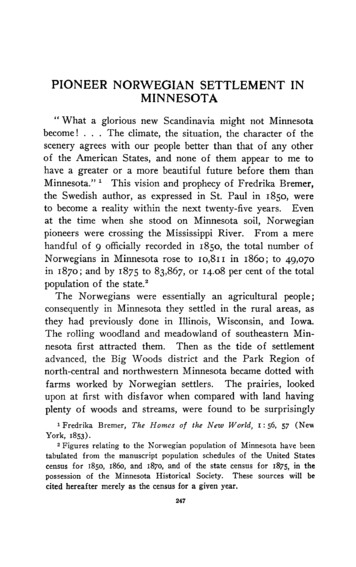
Transcription
PIONEER NORWEGIAN SETTLEMENT INMINNESOTA" What a glorious new Scandinavia might not Minnesotabecome! . . . The climate, the situation, the character of thescenery agrees with our people better than that of any otherof the American States, and none of them appear to me tohave a greater or a more beautiful future before them thanMinnesota." This vision and prophecy of Fredrika Bremer,the Swedish author, as expressed in St. Paul in 1850, wereto become a reality within the next twenty-five years. Evenat the time when she stood on Minnesota soil, Norwegianpioneers were crossing the Mississippi River. From a merehandful of 9 officially recorded in 1850, the total number ofNorwegians in Minnesota rose to 10,811 in i860; to 49,070in 1870; and by 1875 to 83,867, or 14.08 per cent of the totalpopulation of the state. The Norwegians were essentially an agricultural people;consequently in Minnesota they settled in the rural areas, asthey had previously done in Illinois, Wisconsin, and Iowa.The rolling woodland and meadowland of southeastern Minnesota first attracted them. Then as the tide of settlementadvanced, the Big Woods district and the Park Region ofnorth-central and northwestern Minnesota became dotted withfarms worked by Norwegian settlers. The prairies, lookedupon at first with disfavor when compared with land havingplenty of woods and streams, were found to be surprisingly1 Fredrika Bremer, The Homes of the New World, 1: 56, 57 (NewYork, 1853).2 Figures relating to the Norwegian population of Minnesota have beentabulated from the manuscript population schedules of the United Statescensus for 1850, i860, and 1870, and of the state census for 1875, in thepossession of the Minnesota Historical Society. These sources will becited hereafter merely as the census for a given year.247
248CARLTON C. QUALEYSEPT.fertile and excellent farming lands. Consequently the prairielands of southwestern Minnesota and the Red River Valleywere settled. By successive stages, beginning with the firstpermanent Norwegian settler in 1851, the farms of these immigrants from the North spread westward and northwestwardfrom the southeastern corner of Minnesota, until by 1875 theiracres touched the Red River on the opposite border of thestate.Norwegian settlement in Minnesota from 1850 to 1875 canbe conveniently studied in two periods, with 1865 as the approximate point of division. The first, from 1850 to about1865, saw the pioneering of the southern counties of the state.In the second period, from 1866 to the middle seventies, theother large areas of Norwegian settlement in Minnesota weremarked out, chiefly in the western and northwestern counties.During the early sixties a comparative lull in the advance ofsettlement occurred, as a result of the Sioux Outbreak, decreased immigration, and the Civil War. The panic of 1873and the consequent depression, together with the severe grasshopper plagues of the middle seventies, mark the close of aquarter of a century during which the principal areas of Norwegian settlement in Minnesota were pioneered and developed.Until the negotiation of the treaties of Traverse des Siouxand of Mendota in 1851, most of the land in Minnesota Territory was not open for settlement. Before this the region wasof interest chiefly to fur-traders and lumbermen. The agricultural possibilities of the new region were undoubtedlyknown to many and some had actually settled on Indian landswest of the Mississippi before they were acquired by treaty.The negotiations with the Indian tribes attracted widespreadinterest and as soon as the treaties had been concluded the rushof settlers began. Although surveys were not started until1853 and settlers were squatters until the act of August 4,1854, granted preemption rights to those occupying unsurveyed land in Minnesota Territory, by the time that the first
I93IPIONEER NORWEGIANSETTLEMENT249block of government land was placed on sale in 185.5 thousands of settlers — including large numbers of Norwegians —had poured into the new region. The Indian treaties of thefifties and sixties were much needed opening wedges for thesettlers. Up to 1851 the Norwegians who had emigrated to theUnited States numbered 14,654.* The annual influx was comparatively small until 1849, when immigrants began to arrivein large numbers. The 59,620 Norwegians who emigratedto the United States in the years from 1851 to 1865 floodedthe Wisconsin and Iowa settlements and established pioneersettlements in the southeastern part of Minnesota. Whenthe Sioux went on the warpath in 1862, many of theNorwegian pioneers had already penetrated far into northcentral Minnesota. Beginning in 1866 a new and unprecedented wave of Norwegian immigrants crossed the Atlanticto the American shore. Norwegian emigration statistics leapedfrom 4,000 in 1865 to 15,455 in 1866, and the figures continued high until there was a sudden drop from 10,353 i"1873 to 4,601 in 1874, after which the numbers remained lowuntil 1880, when a new wave commenced. Of the 119,545Norwegians who emigrated to America in the decade following 1865, it can safely be estimated that at least half went toMinnesota. A large number of the Minnesota pioneers of Norwegianorigin had lived for varying lengths of time before crossinginto Minnesota in settlements in Wisconsin, Illinois, and Iowa,particularly in the first named state. This was especially trueduring the years before the railroad expansion of the late3 William W. Folwell, A History of Minnesota, 1:266-304 (St. Paul,1921).* Utvandringsstatistikk, 101 (Departementet for Sociale Saker, NorgesOffisielle Statistikk, series 7, no. 25 — Kristiania, 1921).s This estimate is based upon a comparison of the average annual increase of the foreign-born Norwegians in Minnesota and the Norwegianemigration statistics, and it is also supported by contemporary estimates.
250CARLTONC. QUALEYSEPT.sixties and seventies, when the immigrants began more andmore to go directly to their destinations in north-central andnorthwestern Minnesota rather than stop for a time with relatives or friends in older settlements. The bulk of the pioneers,however, seem to have paused for a few weeks or months oreven years in the Wisconsin or Iowa settlements. If theimmigrants arrived late in the summer or in the fall, theyoften found it desirable to stay over the winter with friendsor relatives and to go on again in the spring to their ultimatedestinations. Frequently the settlers in Wisconsin and otherstates who had arrived during the forties and fifties weredissatisfied with their opportunities and, hearing of the boundless expanse of rich lands in Minnesota, also pulled up stakes,sold their holdings, and migrated westward. This process repeated itself over and over again as the frontier advanced.The Norwegian pioneers of southeastern Minnesota migratedfrom earlier Wisconsin settlements; a large number of thosewho made homes in north-central, northwestern, and southwestern Minnesota were from the southeastern part of thestate. As each new area became filled with settlers, each inturn became the source of pioneers for the region just beyond.It is difficult to determine with any degree of exactness thenumber of Norwegians who went from older areas of settlement and those who went directly to Minnesota from Norway.Some clue to the proportions can, however, be gained from themanuscript schedules of the state and federal censuses in thepossession of the Minnesota Historical Society. The followingtable, compiled from these sources, indicates where the Norwegians living in Minnesota in i860, 1870, and 1875 wereborn:
1931PIONEERPLACE OF BIRTHNorwayMinnesotaWisconsinIowaIllinoisNew YorkMichiganCanadaOther In almost all cases the heads of families, both husband andwife, were born in Norway, though this condition was truein a lesser degree in 1875 than earlier, as part of the migrantswere second-generation families. The proportion in the abovetable of the native-born Norwegians to the foreign-born doesnot vary greatly for the three periods, although there is aslight increase in the number of native-born. In i860, 32.69per cent of the total Norwegian population of Minnesota wasnative-born; in 1870, 35.08 per cent; and in 1875, 38.86 percent. Most of those born in the United States were minors;their parents and unattached single individuals usually wereof foreign origin.As Norwegian migration was predominantly a family movement and as the native-born Norwegians were largely membersof families whose heads were born in Norway, it is possibleto determine from the census reports, which indicate familygroupings, the number of Norwegian families that migratedto Minnesota from other states. It is, however, impossibleto determine the extent of this migration within Minnesota.Of the Norwegian families living in Minnesota in 1870, forexample, 1,153 had spent varying lengths of time in Wisconsin, 331 had lived in Iowa, and 149 had spent some timein Illinois. If to these are added the unattached individualsof Norwegian birth and the families that migrated from otherstates, interstate migration takes on considerable proportionsin the total Norwegian immigration to Minnesota.
252CARLTON C. QUALEYSEPT.Perhaps the greatest and most constant attraction in theUnited States for the Norwegian immigrant was the enormousarea of free or cheap land that was gradually being opened tosettlement. It has been estimated that 78 per cent of all theNorwegian immigrants to the United States were from ruraldistricts in Norway, while only 22 per cent were from urbanareas." To the small farmer and the cotter, struggling underalmost constantly adverse economic conditions that were augmented by unsatisfactory political and social opportunities, theprospect of economic independence and political and socialequality in America was alluring. When the Norwegian peasants and cotters learned of the opportunities offered by thepreemption and homestead laws and by land and railroad companies, they emigrated by the thousands.The fact that good land in the vicinity of the Norwegiansettlements in Wisconsin, was largely taken up by 1850 helpedto turn the attention of Norwegian immigrants to Minnesota.As early as 1844 a Norwegian traveler noted in passingthrough Dane County that there was very little room for newcomers. Ole Munch Raeder, who visited the United States in1847 "d 1848, wrote of the Rock Prairie settlement: " I tis said that the whole prairie is bought, except for a fewundesirable parts, so that now one must pay considerably morethan the government price. The price of wood has likewiseincreased so that it is far more expensive here than elsewhereto build houses and fences." ' The Sioux treaties and theresultant booming of Minnesota Territory by newspapers andland speculators were means of calling the attention of theimmigrants to the great new area west of the Mississippi.Without waiting for surveys to be completed, Norwegians as«Olaf M. Norlie, History of the Norwegian People in America, 15(Minneapolis, 1925). Knud Langeland, Nordmandene i Amerika, 68 (Chicago, 1889) ; GunnarJ. Malmin, ed., America in the Forties: The Letters of Ole Munch Rceder,137 (Norwegian-American Historical Association, Travel and DescriptionSeries, vol. 3 — Minneapolis, 1929).
1931PIONEER NORWEGIANSETTLEMENT253well as others set out for the new country. As the tremendousagricultural potentialities of Minnesota were progressivelyrevealed, it became the destination of an ever-growing numberof immigrants and by the middle seventies a considerable shareof the desirable farming land of the state had been claimed byNorwegians.As long as immigrants had to make the long journey fromChicago or Milwaukee overland in oxcarts, immigration toMinnesota necessarily was limited. The construction of thefirst railroads between Chicago and the Mississippi River inaugurated a new era of development for the upper MississippiValley. The spring of 1854 saw the completion of the Chicago and Rock Island Railroad to Rock Island on the eastbank of the Mississippi Successively other roads reachedEast Dubuque, Prairie du Chien, and finally, in October, 1858,La Crosse, just across the river from Houston County, Minnesota. From these points immigrants could take steamersup the Mississippi to St. Paul or could cross the river andproceed to their destinations on foot or in wagons drawn byoxen procured at the river towns.No railroad was operated within Minnesota's borders until1862, and for the first three or four years following that dateexpansion was slow. With the final suppression of the Siouxand the close of the Civil War, railroad building began inearnest and by 1867 it was in full swing. It continued untilthe failure of Jay Cooke and Company in 1873. Norwegiansettlement in southeastern Minnesota had reached its maximum by the time when railroads were constructed there. Inthe northwestern and southwestern areas of the state, however, the railroads were true forces in bringing about settlement. In the former region two lines merit special attention— the St. Paul and Pacific and the Northern Pacific railroads.s Folwell, Minnesota, i : 358; Frederic L. Paxson, " The Railroads ofthe Old Northwest," in Wisconsin Academy of Science, Arts, and Letters,Transactions, 17:243-274 (Madison, Wisconsin, 1914).
254CARLTON C. QUALEYSEPT.The first of these was organized in 1862 as the successor ofthe defunct Minnesota and Pacific Railroad and by 1867 itsline had been constructed from St. Paul along the Mississippito Sauk Rapids. In that year the company began buildingits main line westward through Wright, Meeker, Kandiyohi,Swift, Stevens, Grant, and Wilkin counties to Breckenridgeon the Red River, which was reached in 1871. The NorthernPacific also tapped the rich Red River country when in 1870-71its road crossed the state from Duluth to Moorhead and Fargo.This line's advertising and colonization of the Red River Valley give it its chief significance for the study of Norwegiansettlement. It was never as important from this point of viewas the St. Paul and Pacific, because it did not traverse territory in which the Norwegians settled and because it was inconvenient for immigrants to go to northwestern Minnesota byway of Duluth. Although settlement preceded rail expansion in north-central and northwestern Minnesota, the railroads inevitably played a tremendous role in the development of the new areas. In southwestern Minnesota, on theother hand, such lines as the St. Paul and Sioux City, theWinona and St. Peter, and the Southern Minnesota railroadsin many cases preceded settlement and were instrumental inestablishing colonies on the rolling prairie land there.'While the railroads promoted the development of new areasof settlement, they were also active in attracting settlers totheir lands. There is little evidence to indicate that Norwegians settled to any great extent on the lands of the Northern Pacific in Minnesota, but the extensive campaign carriedon by the agents of that company in the Scandinavian countries and in other European countries did much to attract theattention of prospective emigrants to Minnesota and the Da Harold F. Peterson, " Railroads and the Settlement of Minnesota,1862-1880," 59, 65, 86. This is an unpublished master's thesis preparedat the University of Minnesota in 1927. The Minnesota Historical Societyhas a copy.
1931PIONEERNORWEGIANSETTLEMENT255kotas. The railroads cooperated with the state board of immigration in its advertising program and in the transportationof immigrants. The Northern Pacific was perhaps the mostactive road in this respect, but the St. Paul and Pacific, theLake Superior and Mississippi, and the St. Paul and SiouxCity also attempted to attract settlers."The Minnesota territorial legislature in March, 1855, passedan act providing for an immigration commissioner to be stationed in New York. He was to reside there, to meet immigrants and distribute literature about Minnesota, to try todirect immigrants to Minnesota, and to advertise Minnesotain newspapers and pamphlets in the United States and abroad.The law, which was reenacted in 1856, remained in operationfor two years. Most of the efforts of the agent, EugeneBurnand, were directed toward attracting Belgians and Germans to Minnesota, the Scandinavians receiving only incidentalattention. Although the activities of the territorial government had little effect upon Norwegian immigration to Minnesota, those of the state government in the late sixties and earlyseventies were influential. On March 14, 1864, the Minnesotalegislature passed an " Act to organize a system for the promotion of immigration to the state of Minnesota." The secretary of state was designated commissioner of immigration,a contest for the preparation of advertising pamphlets was arranged, and appropriations of three thousand dollars in 1865and one thousand dollars in 1866 were made for their publication and distribution. Of a pamphlet in the Norwegian language, the secretary of state in his report to the legislature of1865 remarks: " The Norwegian pamphlet, though only re1" Peterson, " Railroads and the Settlement of Minnesota," 29-36.This thesis includes an account of the activities of the railroads in encouraging settlement, as does also James B. Hedges, " The Colonization Work ofthe Northern Pacific Railroad," in Mississippi Valley Historical Review, 13:309-342 (December, 1926).11 Livia Appel and Theodore C. Blegen, " Official Encouragement ofImmigration to Minnesota during the Territorial Period," ante, 5: 167-203.
256CARLTON C. QUALEYSEPT.cently in readiness owing to the difficulty of procuring theproper translation, is being rapidly sought for." Later reportsby the board of immigration indicate that the demand forthe pamphlets far exceeded the supply.The desirability of more extensive activity in the promotionof immigration led to the passage of an act in 1867 creatinga board of immigration composed of three members — thegovernor, the secretary of state, and one other member to beappointed by the governor. For the work of the board, tenthousand dollars was appropriated. Its report to the legislature in 1867 reveals that five thousand copies of a Norwegianpamphlet had been sent out on demand. In 1871 fifty-sevenhundred copies were issued and in 1872, three thousand. Inaddition to publishing and distributing such materials, theboard maintained agents at various ports to meet immigrantsand to advertise the state both in America and abroad throughnewspapers and by other means. According to the report ofthe board for 1870 it had established immigrant houses invarious cities where immigrants could be accommodated forshort periods, such as overnight, while on their way to Minnesota. Hans Mattson, the first secretary of the board andlater secretary of state, was a prominent Swedish immigrantwho did much to stimulate Scandinavian immigration; and inthe work of the board he associated with him such men asJohan Schroder, a Norwegian immigrant journalist, whoserved as secretary; and K. Hasberg, T. K. Simmons, andD. Wanwig, agents respectively at Milwaukee, Quebec, andTrondhjem, Norway. After 1872 state activity in encouraging immigration lapsed and no new legislation was enacteduntil 1878."12 Minnesota Secretary of State, Reports, 1865, p. 115; Minnesota,General Laws, 1864, p. 64-67; 1867, p. 52. The board was reorganized bylegislative acts in i860, 1870, and 1871. In 1869 its membership wasincreased to five.13 Theodore C. Blegen, " Minnesota's Campaign for Immigrants," inSwedish Historical Society of America, Yearbooks, 11:24 (St. Paul,
1931PIONEERNORWEGIANSETTLEMENT257Among the individuals who were highly influential in attracting Norwegians to Minnesota was the pioneer Danishpastor and farmer, the Reverend Claus L. Clausen, one of themost prominent and vigorous characters in the early historyof Norwegian settlement. Though not an ordained minister,he became the pastor of the Norwegian-Lutheran congregationat Muskego, where he arrived from Europe in the summer of1843, " he remained there until the spring of 1846, when heremoved to Koshkonong. Soon thereafter he was called aspastor to the Rock Prairie settlement, where he lived for several years, serving congregations in Rock County and theadjoining territory. * Through his religious leadership, hisjournalistic activities, and his long and numerous journeysamong the settlements in southern Wisconsin, Clausen achieveda position of great prestige and influence among the Norwegianpioneers. Hundreds of Norwegian immigrants went to himfor advice and aid and he helped them earn a temporary livelihood and find land. The increasing number of immigrantsand the gradually diminishing supply of good land near thesouthern Wisconsin settlements made the problem of caring fornew immigrants increasingly serious. Clausen's attentionwas naturally attracted to Minnesota.Early in 1850,when it had just become a territory and steps were beingtaken to acquire the land from the Indians, he wrote aletter to Governor Alexander Ramsey inquiring about theopportunities offered in Minnesota Territory for immigrants.Ramsey's reply is not preserved, but it must have been satisfactory, for in the summer of the same year Clausen with some1926). The Minnesota Historical Society has copies of the Reports of theMinnesota State Board of Immigration for 1867 and 1871; that for 1870is published in Norwegian translation in the Nordisk Folkeblad (Minneapolis) for January 25, 1871.1 Margareth A. Jorgensen, "Claus L. Clausen, Pioneer Pastor andSettlement Promoter," a master's thesis prepared at the University ofMinnesota in 1930. The Minnesota Historical Society has a copy.
258CARLTONC. QUALEYSEPT.companions made a trip up the Mississippi to St. Paul andthence to St. Cloud. Later he traveled up the MinnesotaRiver some forty miles, and through the region east of LakeSt. Croix. On August 14, 1852, he set out with two companions for a second journey into the region west of the Mississippi. This time he was personally interested in locatinga new home. He traveled as far west as the Albert Learegion in Minnesota and then turned southward into Iowa,until he finally found satisfactory land at the confluence ofthe Big and Little Cedar rivers. In two letters to the Norwegian newspaper, Emigranten, Clausen described the regionto which he expected to migrate in the spring of 1853. Theseletters were an important factor in acquainting the Norwegiansof southern Wisconsin and newly arrived immigrants with thelands west of the Mississippi. In May, 1853, Clausen, hisfamily, and about forty other families left Rock Prairie forMitchell County, Iowa, where they founded the settlementknown as St. Ansgar. This became a Norwegian center innorthern Iowa and a point of dispersion for Norwegian settlements in southern Minnesota. Clausen's prestige among theNorwegian pioneers made the information and advice he dispensed doubly acceptable, and through his writings and hispersonal contacts he exercised great influence in pointing Norwegian settlement toward southern Minnesota in the earlyfifties."Paul Hjelm-Hansen perhaps had more influence than anyother individual on Norwegian settlement in Minnesota. Itwas he who made the Norwegians conscious of the tremendousagricultural possibilities of the Red River Valley and who was1' Clausen's letter to Ramsey, which is dated January 22, 1850, isamong the Ramsey Papers in the possession of the Minnesota HistoricalSociety; those to Emigranten (Madison, Wisconsin) appear in the issuesof that paper for October i, 1852, and April 29, 1853. These letters,edited by the present writer, will appear in volume 6 of the NorwegianAmerican Historical Association's Studies and Records." Jorgensen, " Qaus L. Clausen," 80-87.
1931PIONEERNORWEGIANSETTLEMENT259to a considerable extent responsible for the peopling of "theRed River country with thousands of Norwegian farmers.Hansen left Norway for the United States in 1867 with asuccessful career as a publicist and editor behind him. He wasthen fifty-seven years of age. For a time he was a memberof the staff of a Norwegian newspaper, Fcedrelandet og Emigranten ( " T h e Fatherland and the E m i g r a n t " ) , publishedat La Crosse, Wisconsin, and his writings and activities soonbrought him into prominence among the Norwegians in theNorthwest. On June 5, 1869, he was appointed by GovernorWilliam R. Marshall to act as a special agent of the Minnesota state board of immigration. H e was to travel about inthe state, particularly in unsettled areas, and was to reportupon possibilities there for immigrant settlement. Hansenwent immediately by river and stage to Alexandria in DouglasCounty. From this point he set out on July 12, 1869, withtwo companions in an ox-drawn wagon for a trip of threeweeks into the Red River country. The party traveled in anorthwesterly direction through Douglas, Otter Tail, Wilkin,and Clay counties to the Red River at Breckenridge, whereit turned northward to Fort Abercrombie. It went fifty milesfarther to Georgetown before turning back. Immediatelyupon his return to Alexandria, Hansen wrote a detailed account of his journey, which was published in several Scandinavian papers of the Northwest. This article, entitled" From the Red River Country," describes in glowing termsthe advantages of the new territory for farming and urgesNorwegians to claim these lands before speculators seize them.He wrote several additional letters to newspapers, particularlyto the Nordisk Folkeblad and Fcedrelandet og Emigranten,describing the region of the Red River and the counties to thesouth and east, such as Douglas, Otter Tail, Grant, Pope, and''''Nordisk Folkeblad, August 11, 1869; Fcedrelandet og Emigranten(La Crosse, Wisconsin), August 12, 1869; Amerika (Winona), September33, 1869; Minnesota Tidning (St. Paul), January 14, 1870.
26oCARLTON C. QUALEYSEPT.Kandiyohi. Hansen also visited the Minnesota River settlements and those in Goodhue County, but his work there wasnot especially significant. In all, sixteen articles from his handappeared in the Nordisk Folkeblad, giving accounts of histravels and all manner of information about unsettled areasthat would be useful to the prospective settler. Hansen continued to be active in the field of journalism until his deathin 1881, but he is especially remembered for familiarizing Norwegians both in Norway and in America with the advantagesof the Red River Valley and northwestern Minnesota. Thepublication of his letters was followed within a year by a tremendous influx of Norwegian settlers. Immigrants fromNorway and Norwegians from older settled areas flocked to the" New Canaan " in northwestern Minnesota, of which Hansenwrote so enthusiastically. *The influence exerted by the Norwegian-American pressand by the so-called "America letters" is important. Although the pre-Civil War Norwegian newspapers, largely published in Wisconsin, had relatively little influence on Norwegiansettlement in Minnesota, those established in the later periodmade every effort to attract Scandinavians to that state. Inthe America letters Norwegian immigrants described for thebenefit of relatives and friends who had remained in Norway their experiences and the state and community in whichthey had settled. In view of the thousands of Norwegianswho went to Minnesota, it is natural that these letters shouldcontain a store of information about this rich new state. A\' Nordisk Folkeblad, April 16, 30, 1868; July 14, 1869, to February2, 1870; Axel Tollefson, " Historical Notes on the Norwegians in the RedRiver Valley," in North Dakota Historical Collections, 7:133-147 (1925).For contemporary evidence of Hansen's influence, see a letter writtenby P. O. Ingebriktsen on August 20, 1875, and published in Budstikken(Minneapolis) for August 24, 1875. A translation of part of this letteris included in the present writer's article entitled " Pioneer NorwegianSettlement in North Dakota,' in the North Dakota Historical Quarterly,5:20 (October, 1930).
1931PIONEERNORWEGIANSETTLEMENT261though some of the letters were pessimistic in tone, the largemajority were very optimistic, emphasizing the fact that forthe man who was willing to work there were opportunitiesin America that would never appear in Norway. "In contrast to the aids to settlement described above, therewere a number of obstacles to the advance of the pioneers, themost serious of which was the Sioux Outbreak. Along thefrontier of western Minnesota, which included the most western of the Norwegian settlements in Jackson, Brown, Renville, Chippewa, and Kandiyohi counties, the pioneers wereterrified by the swift and terrible outburst that began on August 18, 1862, and they fled eastward by the hundreds. " Thepanic spread into the older areas of settlement and for a timethe state was an armed camp. It was not until late in the fallthat the strength of the Sioux was effectively broken. In thesucceeding three years there were recurrent raids and furtheroutbreaks, chiefly in the Dakotas, but there was constant fearthat the Indians would again attack in Minnesota. It tookmany years to overcome the widespread fear of the Indians,and, although the settlers, especially in southwestern Minnesota, began to enter again soon after 1865, no really extensive1' Among the Norwegian-American newspapers that did much toencourage immigration are the Nordisk Folkeblad, Emigranten, Fcedrelandetog Emigranten, Skandinaven (Chicago), Minnesota (Minneapolis), Budstikken, Amierika, Skandinaviske Democrat (La Crosse, Wisconsin),Decorah [Iowa] Posten, Nordvesten (Madison, Wisconsin), and Norden(Chicago). With the exception of the Nordisk Folkeblad and Budstikken,files of which are owned by the Minnesota
Of the Norwegian families living in Minnesota in 1870, for example, 1,153 had spent varying lengths of time in Wis consin, 331 had lived in Iowa, and 149 had spent some time in Illinois. If to these are added the unattached individuals of Norwegian birth and the families that migrated from other


